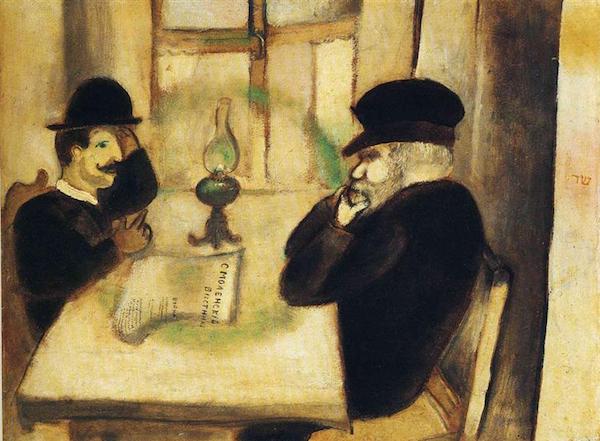
Marc Chagall The Smolensk newspaper 1914

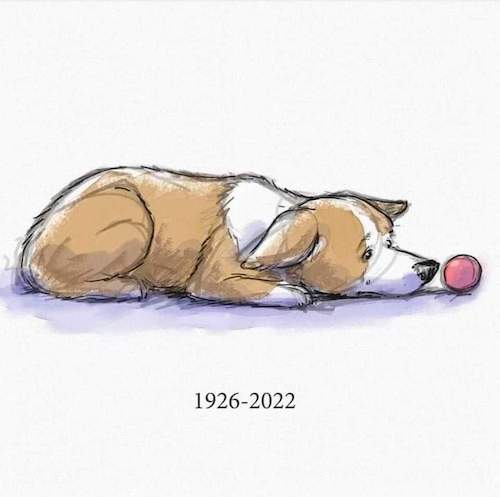





Sean Lock
rip sean lock you would’ve loved this pic.twitter.com/Pm0a7J4m4W
— juIia (@scholarschism) September 8, 2022

Putin: We are the flesh and blood of our heroes
Putin warns countries that mock history and tear down monuments honoring the Soviet sacrifice in World War II. pic.twitter.com/oqXI9TyjRs
— Putin Direct (@PutinDirect) September 9, 2022


He’s not stupid enough to actually believe this. He’s a second hand car salesman.
• Ukraine Will Retake Crimea In A Year – Ex-US General (RT)
Ukraine could “restore full sovereignty” within a year, retaking all of its lost territory including Crimea, retired US General Ben Hodges told Newsweek on Thursday at the Tbilisi International Conference of the McCain Institute in Georgia. Hodges is now a lobbyist at the Centre for European Policy Analysis, a pressure group funded by NATO and US arms manufacturers. Western support for Kiev has resulted in a financial bonanza for these companies. “The Ukrainians saved their country,” Hodges gushed, declaring that “half a year after the start of the full-scale Russian invasion…the supposed second-best army in the world is now the second-best army in Ukraine,” with Russia’s “ability to conduct further offensive operations…all but exhausted.”
Now, Hodges said, it was up to the US and NATO to step in and make sure the war is won, starting with a full-throated proclamation of support for Kiev. Washington should stop publicizing the cost of the military aid it sends overseas, he continued, suggesting the deliveries be framed in terms of the percentage of “what is needed for Ukraine to defeat Russia and regain their territory.” The retired general did not elaborate on how those numbers could be calculated. The administration of US President Joe Biden has poured over $44 billion into the war effort since February. While Ukraine and its Western backers have declared the Kherson counteroffensive a rousing success, boasting of recapturing several villages, Kiev has banned journalists from the front lines, making these claims difficult to verify.
Russia has argued the initiative “failed miserably,” pointing to the loss of over 1,200 Ukrainian servicemen in a single day of fighting. Ukrainian MP Alexey Goncharenko echoed Hodges’ optimism in comments to Newsweek, declaring “next year will be the decisive year of the war” and that “with the help of the free world, Ukraine has an opportunity to win.” That will require a lot more weapons, he clarified, mentioning aircraft, air defense systems, and rockets superior to the HIMARS. Crimea became part of Russia in the wake of a 2014 referendum following the US-backed overthrow of the democratically-elected government of Viktor Yanukovich in Kiev.
Ukraine and NATO consider it illegally annexed territory, and the US has reportedly given Ukrainian President Vladimir Zelensky the go-ahead to attack the peninsula. The Donbass republics of Donetsk and Lugansk declared their independence that same year and were recognized as independent states by the Kremlin this past February. Zelensky has vowed to retake all three regions, promising on Sunday that “Ukraine will return” to Donbass, Kharkov, Zhaporozhye, Kherson, and “definitely to Crimea.”
Putin 2007
According to Jen Stolenbeg, NATO is deploying new forces on the eastern border, sending a clear signal to the Russian Federation that it will defend every inch of its territory.
Vladimir Putin called out NATO’s expansion into Russia’s borders back in 2007. pic.twitter.com/f0gTQpf1LK
— Fiorella Isabel (@FiorellaIsabelM) September 9, 2022

Ukraine has no nukes.
• Ukraine’s Top General Doesn’t Rule Out “Limited” Nuclear War (ZH)
Ukraine’s top military chief has warned that Russia could unleash nukes if its army is against the ropes in Ukraine. The comments were issued Wednesday amid an ongoing Ukrainian counteroffensive in the south and east which both Kiev and Washington say has so far had “success”. Commander-in-Chief of the Armed Forces Gen. Valery Zaluzhny stated “There is a direct threat of the use, under certain circumstances, of tactical nuclear weapons by the Russian armed forces.” He wrote this in an op-ed published by state run outlet Ukrinform, with the alarming words being picked up by The Washington Post and others. “It is also impossible to completely rule out the possibility of the direct involvement of the world’s leading countries in a ‘limited’ nuclear conflict, in which the prospect of World War III is already directly visible,” Zaluzhny added.
The top commander further issued his first official confirmation that the unprecedented large strikes on Russia’s Crimea bases and an arms depot widely reported in August were Ukrainian operations. The initial early August huge Saki air base explosion had previously only been acknowledged as a Ukrainian strike via anonymous leaks to Western media outlets by senior Kiev officials. At around the same time as those opening Crimea attacks, which have continued sporadically since then, President Zelensky vowed to “liberate” the Russian-held territory, which the Kremlin gained control of after a 2014 popular referendum, which wasn’t recognized by Europe or the US. According to Gen. Zaluzhny’s words as featured in The Washington Post:
“With the fighting all but certain to continue into 2023, Ukraine has to make the war “even sharper and more tangible for the Russians and for other occupied regions, despite the massive distance to the targets,” Zaluzhny wrote. He called the Crimean strikes a “convincing example” of Kyiv’s calls for allies to send longer-range weapons for its outgunned soldiers. Moscow, he said, can hit 20 times farther.” Moscow for its part has also expressed alarm over the potential for nuclear-armed confrontation with the West over Ukraine, given Washington’s steadily growing involvement – especially the billions of dollars in weapons and military aid being poured into the Ukrainian side. It has also rejected charges that it is prepared to use nukes.

I’m going to have to get back to this in a separate article. They are trying to create a world war.
• Zelensky Is Literally Selling Ukraine To Wall Street Corporations (Norton)
Ukraine’s Western-backed leader Volodymyr Zelensky virtually opened the New York Stock Exchange on the morning of September 6, symbolically ringing the bell via video stream. Zelensky announced that his country is “open for business” – that is to say, that foreign corporations are free to come and exploit its plentiful resources and low-paid labor. In a speech launching the neoliberal selloff program Advantage Ukraine, Zelensky offered Wall Street “a chance for you to invest now in projects worth of hundreds of billions of dollars.” The financial news service Business Wire published a press release from the Ukrainian government in which Zelensky boasted:
“The $400+ [billion] in investment options featured on AdvantageUkraine.com span public private partnerships, privatization and private ventures. A USAID-supported project team of investment bankers and researchers appointed by Ukraine’s Ministry of Economy will work with businesses interested in investing.” It also quoted the president of NYSE Group, Lynn Martin, who said: “As the largest exchange globally, we stand for freedom, investor protection and unfettered access to capital. We are pleased to welcome President Zelenskyy virtually to the NYSE bell podium, a symbol of the freedom and opportunity our U.S. capital markets have enabled around the globe. We are honored the President has chosen the NYSE to mark the kickoff of Advantage Ukraine and engage with the world’s business community.”
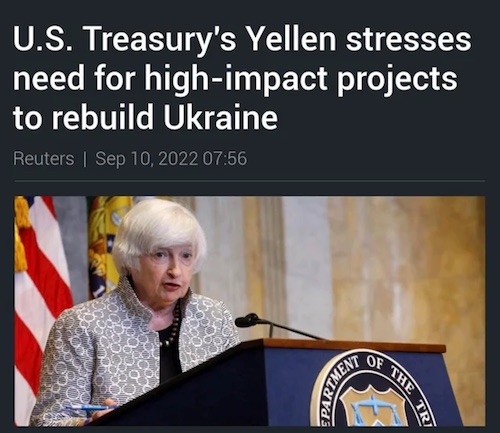
The press release cited executives of US corporate giants Google, Alphabet, and Microsoft, who salivated over the economic possibilities offered by Ukraine. Reuters noted that the Ukrainian government hired British public relations firm WPP to run the marketing operation for Advantage Ukraine. Zelensky coordinated his New York Stock Exchange publicity stunt with an editorial in the Wall Street Journal imploring US capitalists to “Invest in the Future of Ukraine.” “I committed my administration to creating a favorable environment for investment that would make Ukraine the greatest growth opportunity in Europe since the end of World War II,” Zelensky wrote. He continued:
“To create a safe, transparent environment for business engagement, Ukraine is pursuing investment guarantees from both the Group of Seven and the European Union, reforming the country’s tax system, and establishing a strong new legal framework. Our country has already adopted rules and laws to allow companies to build transparent corporate structures, attract foreign investment more easily, and use additional mechanisms to protect intangible assets. Favorable conditions will allow us to establish Ukraine as a powerful IT hub and implement innovative business ideas quickly and effectively.”
In an interview with Multipolarista, economist Michael Hudson compared the new emergency anti-labor laws imposed by the Ukrainian government to the brutal neoliberal policies implemented by Chile’s far-right Pinochet dictatorship after a CIA-backed coup in 1973. “It’s jaw dropping,” Hudson said of Zelensky’s Wall Street Journal op-ed. “It’s like a parody of what a socialist would have written about how the class war would be put in into action by a fascist government.” “So of course he was welcomed on the stock exchange for abolishing labor’s rights,” Hudson added. “You could not have a more black-and-white example” of class war. “This is exactly what [French President] Macron said when he said the ‘end of abundance.’ The Ukrainian labor force has just experienced the end of affluence, neoliberal style.

Izyum is pivotal. Russia took it very early in the SMO.
“..they are attempting a thrust toward Kupyansk, with the aim of cutting the line connecting Izyum to Belgorod in the north. This operation, I believe, is doomed to spectacular failure.”
• Ukraine Counterattacks! Please Remain Calm (Big Serge)
A modest city with a prewar population of perhaps 50,000 people, Izyum was always slated to be a focal point in this war, due to its location at a critical intersection. The topography of northeastern Ukraine is dominated by a few critically important features which determine patterns of movement. These include the crucial E40/M03 highway, which connects the metropolis of Kharkov and the urban agglomeration of Slovyansk and Kramatorsk, which are the largest and most important cities in the western Donbas. The region is furthermore shaped by the Severodonetsk River – alternatively called simply the Donets (from which the Donbas, or Donets Basin, draws its name) – which snakes lazily around the plain.
The Donets forms a geographic barrier between the Donbas to the south and the Kharkov region to the north, while the E40/M03 highway forms the main arterial for transit between Kharkov and the urban centers of the western Donbas. Izyum is a strategically crucial city because it is where the highway crosses the river; as an added cherry on top, the Oskil River – a major tributary of the Donets – confluences with the Donets less than five miles to the east of Izyum, meaning the city essentially sits directly on the intersection of all the most important geographic features of the region. A highly simplified map of the area looks like this:
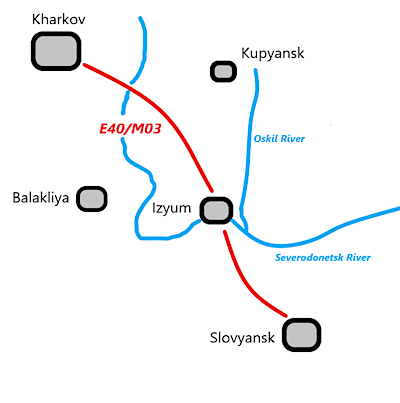
Capturing Izyum was a major objective for Russia in the early weeks of the war (as I argued in a previous piece, this was a major reason for the pinning move on Kiev), because it not only interdicts and complicates supply to Ukrainian forces in the Donbas, but it also gave Russia an early position on the Donets river. It is obvious why Ukraine would want to dislodge Russia from Izyum. This would simplify and secure lines of communication to Slovyansk and greatly complicate the Russian push in the Donbas by freeing Ukraine’s northern flank. To achieve this, they are attempting a thrust toward Kupyansk, with the aim of cutting the line connecting Izyum to Belgorod in the north. This operation, I believe, is doomed to spectacular failure.

From same long article by Big Serge.
“..a salient is a position where a force is already encircled on 3 sides, leaving only the exit to be snapped shut.”
And then it becomes a cauldron.
• Izyum: The Non-Salient (Big Serge)
In military parlance, a “salient” simply means a bulge in the frontline, where one side has achieved some level of penetration at a particular point. A salient is a classically vulnerable position – a glaringly obvious operational focal point, because simultaneous attacks at the base of the bulge can easily cut it off and trap the forces inside. Essentially, a salient is a position where a force is already encircled on 3 sides, leaving only the exit to be snapped shut. In the opening phase of the war, Izyum was indeed a salient. Russia had captured an exposed position which jutted out into Ukrainian territory, and there was talk of a Ukrainian counteroffensive to take advantage of this. Furthermore, the only safe supply line to Izyum ran through Kupyansk, making this a vulnerable position indeed. However, throughout the following weeks, Russia took control of the territory directly to the east of Izyum, including the town of Lyman.
This concretized the Russian flank and secured additional lines of communication into Izyum, creating redundancies for the highway from Kupyansk. The window of opportunity for an easy encirclement or interdiction of supply to Izyum ended when Russia cleared all the Ukrainian forces from the north side of the Donets river. Supply lines to Izyum are now shielded from the south by the Donets, and from the west by the Oskil. Because Russia has redundant supply lines to the northeast of Izyum, for Ukraine to reach operational depth, they must cross the Donets and Oskil rivers. Even suppressing Kupyansk is not enough to disrupt Russia’s ability to project force here. The Oskil river – which, incidentally is more than a kilometer wide in places – presents a major barrier that will prevent Ukraine from exploiting their early advances. They have more or less advanced into a wall, and already the map presents an unfolding catastrophe for them. Courtesy of Rybar:
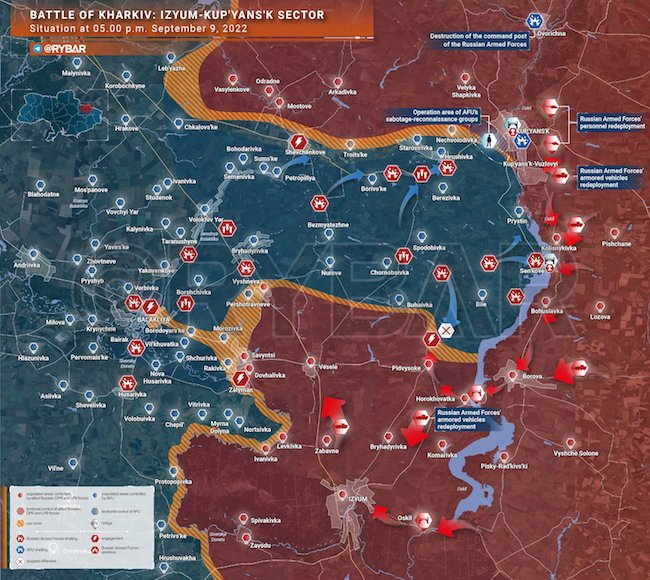
“This is a Salient with Ukrainians inside”
In short, the Ukrainian advance has been too slow and lacks a clear path to reach operational objectives. Already, Russia has begun to deploy huge reserves to this theater, and fear is beginning to show among the more operationally aware Ukrainians. One Ukrainian journalist at the front had this to say: “There is heavy fighting near Kupyansk, worse than Balakleysky. We are taking heavy losses. The enemy is transferring a bunch of reserves by air. The “Wagnerites” have already arrived in the city itself. The sky is filled with aircraft. Hearing about all this, a haunting feeling of an ambush arises in the soul. What if this all really turns out to be a strategic level ambush?”
I do not believe this is an “ambush” per se by the Russian army. The word ambush implies that the Russian forces were already in position, drawing the Ukrainians into a specific maneuver plan where they could be attacked from prepared positions. That’s not what’s happening at all – Russian forces are coming in fresh from reserve and were not pre-deployed to the sector. What the operation reflects instead is Russia’s preference to wage a high-firepower, mobile defense. Frontline positions are, relatively speaking, thinly manned, which powerful mobile reserves are held back. This is a flexible, firefighting approach which allows the Ukrainians to advance into vulnerable positions so that they can be destroyed.

US/NATO wants a price cap on Russian gas only. De Croo wants a cap on all gas.
• Belgium Objects To Russian Gas Cap Plan (RT)
Imposing a price cap on Russian gas would be insufficient, Belgian Prime Minister Alexander De Croo has said, calling for the proposed ceiling to be applied to all gas imported into the European Union. In an interview with POLITICO on Thursday, De Croo said this “key measure” on the part of the bloc “needs to [include] all types of gas.” He also warned that failure to heed his advice would be a “big mistake.” In the Belgian official’s view, the price cap would have to be implemented in a “dynamic way,” that is, making sure it would still make sense for exporters to sell gas to the EU instead of shifting to Asian markets. De Croo clarified that with the current gas prices in Asia being roughly 50% lower, setting the price cap just 5 percent higher than Asia would ensure that “all traders in the world will still continue to sell in Europe.”
Earlier on Thursday, Belgium’s Energy Minister revealed that his country would not support the European commission’s plan to impose a price cap specifically on Russian gas imports. “A cap on Russian gas only is a purely political objective,” the minister said, adding that Belgium “will not agree to this” as it did not “see the added value in that.” De Croo has been lobbying his plan since March, and while some member states such as Poland and Greece back the proposal, others, like France, remain skeptical, POLITICO reports. Gas prices in Europe surged following the start of Russia’s military offensive in Ukraine in late February and have remained considerably higher than last year’s levels. This has led to a rise in overall inflation.
Last Friday, Russian energy giant Gazprom announced that it would not resume supplying gas to EU consumers via the Nord Stream 1 pipeline, citing sanctions-related maintenance issues. The bloc, meanwhile, has accused Russia of weaponizing energy supplies.

“If price restrictions were to be imposed exclusively on Russian gas, that would evidently lead to an immediate cut-off in Russian gas supplies. It does not take a Nobel Prize to recognize that,” he warned.”
• EU Fails To Agree Russian Gas Price Cap – Hungary {(RT)
EU energy ministers have failed to reach a consensus on setting a price cap on Russian gas at an emergency meeting on Friday, Hungarian Minister of Foreign Affairs Peter Szijjarto told reporters. “Today there was no solution, there was only a political dispute, which served as a reference point for the European Commission. We now expect that next week or the week after that, not only the member states, but also the European Commission will make written, substantial proposals,” Szijjarto said, as cited by RIA news agency. Earlier this week, the European Commission prepared suggestions on measures aimed at tackling rising energy prices, which were to be discussed by the energy ministers.
Among them was the proposal to introduce a price cap on Russian pipeline gas. The idea, however, faced opposition among member states and was not widely supported at Friday’s meeting, Reuters reported, citing two unnamed diplomats. Earlier, reports also emerged that some EU countries suggested that a price cap should not single out Russia, but instead be applied to all gas imports to the bloc. In a Facebook video posted ahead of the meeting, Szijjarto said the proposed price cap on Russian gas goes against both European and Hungarian interests. “If price restrictions were to be imposed exclusively on Russian gas, that would evidently lead to an immediate cut-off in Russian gas supplies. It does not take a Nobel Prize to recognize that,” he warned.
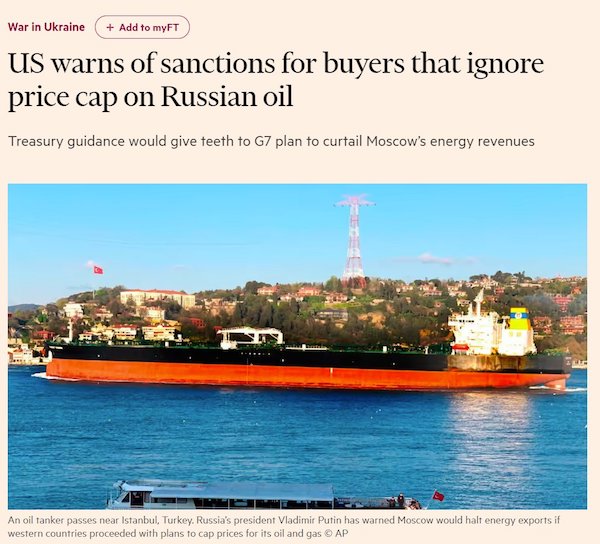
@WallStreetSilv: They seriously are going to get the rest of the world to quit using the US Dollar with their arrogance on this issue. They are pushing the entire world towards China and the BRICS.

Germany screwed up its energy policy like no-one else. And now they resort to blackmail.
• Germany Frustrated Over Neighbors’ Gas-sharing Reluctance – Bloomberg (RT)
Germany’s neighbors Belgium, Luxembourg, the Netherlands and Poland have refused to engage in “constructive negotiations” about gas solidarity deals, Economy Minister Robert Habeck said in a report to lawmakers seen by Bloomberg. The paper, which was presented to the Bundestag’s energy and climate committee late on Wednesday, reportedly assumed that the reluctance could exacerbate the gas crunch in Germany “because a substantial building bloc of the EU’s gas crisis resilience in the form of bilateral agreements would not be available.” The gas-sharing pacts between member states are part of a larger EU mechanism for energy emergency situations. They guarantee that one country will supply the other if they don’t have enough gas to provide the needs of households and social services, which enjoy special protection under EU law.
According to Habeck, the main reason the countries are refusing bilateral agreements with Berlin is because they don’t want to be on the hook to compensate their suppliers in case gas gets rerouted to Germany. The economy minister also highlighted that Germany is in talks with Italy and the Czech Republic. The agreement with Italy would be a trilateral deal involving Switzerland as gas would need to transit that country into Germany. Discussions with Rome are on hold until after elections later this month, Habeck noted. The Czech Republic would be willing to sign such an agreement, but only if there’s a cap on government compensation for suppliers. Given these problems, “there is currently no progress to be expected from negotiations about bilateral solidarity agreements,” Habeck stressed in the report.

Makes Trump look awfully smart.
• Germany Is Now Generating Nearly A Third Of Its Electricity From Coal (BI)
Germany is relying more on coal to generate electricity, as Russian gas cuts force the country to seek alternative sources of fuel before winter. The European nation produced 82.6 kilowatt-hours of electricity from coal-fired power plants in the first six months of 2022, a 17.2% rise from the the same period last year, according to new data from Germany’s national statistics office, Destatis. As a result, it generated 31.4% of its electricity from coal. Meanwhile, Germany slashed its electricity production from natural gas, reducing it from 14.4% to 11.7% of its total electricity mix, Destatis noted. Soaring prices have made natural gas less and less affordable in recent months.
The shift from gas to coal highlights Germany’s desperate efforts to stockpile fuel before cold weather takes hold later this year, as repeated gas cuts from Russia deplete European supplies. Russia has been accused of “weaponizing” energy in retaliation to Western sanctions and boycotts imposed on the nation following its invasion of Ukraine. Given coal is cheaper than gas and a more accessible fuel resource for Germany, the country has effectively been forced it to make a u-turn back to the dirtiest fossil fuel. One of its energy companies, Uniper, recently fired up a mothballed coal-fueled power plant to cut its dependency on Russian energy. Dutch TTF natural gas futures, the European benchmark for natural gas prices, have been soaring as the market tightens, with prices reaching record highs above 340 euros this year.
Prices were down 4% at 204 euros at last check Thursday, thanks to prospects of a European plan to cap Russian gas prices. Rotterdam coal delivery for October fell 5% to $338, down from more than $430 in March, according to ICE Futures. Analysts warned that greater demand for coal could dial up the cost of the commodity. “When nat gas is this expensive then consumers prefer coal and oil instead, so this goes also up in price,” SEB analyst Ole Hvalbye told Insider. While Europe faces a crippling energy crisis, Germany has been hit the hardest with one of the country’s biggest banks, Commerzbank, predicting it could fall into a 2009-style recession if Russia permanently chokes off supply.

As Putin said.
• Ukrainian Grain Going To EU Instead Of Africa – El Pais (RT)
At least 38% of the grain exported from Ukraine under the UN-brokered deal is shipped to the EU instead of the developing countries in Africa for which it was intended, Spain’s El Pais newspaper reported on Thursday, citing UN data and ship tracking figures. According to the report, more than 2.3 million tons of corn, wheat, barley and other agricultural products were exported through the Black Sea corridor from Ukraine between August 1 and September 7. Of this total, about 900,000 tons were sent to the ports of EU member states. The report notes that it is impossible to trace from the available data whether the EU is the final destination of the shipments or a transit point. On July 22, multilateral agreements were signed in Istanbul establishing the framework of exports of Ukrainian grain, food, and fertilizers via the Black Sea.
The agreements also lifted restrictions on Russian grain and fertilizer exports. However, according to Russia’s permanent representative to the UN, Vassily Nebenzia, the part of the food deal that concerns the export of Russian products has not been implemented, which could lead to the termination of the deal by Moscow. Speaking at a plenary session of the Eastern Economic Forum on Wednesday, Russian President Vladimir Putin accused Western nations of lying when they claimed Ukraine needed access to sea shipping to alleviate surging food prices and the risk of famine in poor countries, as a lion’s share of the grain is being exported to Western states. In his remark earlier on Thursday, Turkish President Recep Tayyip Erdogan sided with the Russian leader, saying that Ukrainian grain is “unfortunately” going mostly to rich countries.

“..disproportionate grain exports under a UN-brokered deal that can offset massive debts for weapons and aid..”
Any questions?
• Ukraine Faces Winter Food Shortages – Economist (RT)
Ukraine may face food shortages this winter due to disproportionate grain exports under a UN-brokered deal that can offset massive debts for weapons and aid. That’s according to economist Yegor Klopenko, founder of the ITLEADERS venture investors club, who spoke to the news agency Prime on Friday. Ukraine’s debt to the West grew by $70-100 billion just in the first half of the year, according to Klopenko’s estimates. He is certain that Ukraine will never be able to repay this money. Instead, it is bartering its grain in an effort to ensure more aid in the future. “As a result, Ukraine may have problems with food, as the authorities there are ready to give the West everything without thinking about the population,” he says.
More than 2.3 million tons of corn, wheat, barley and other agricultural products were reportedly exported through the Black Sea corridor from Ukraine between August 1 and September 7. Spain’s El Pais newspaper on Thursday reported that at least 38% of this grain is currently shipped to the EU instead of developing countries in Africa for which it was intended. “In turn, Europe cannot admit publicly that Ukrainian grain will end up on the tables of Europeans and not in starving Africa,” the expert states, adding that he thinks that, thanks to Russia’s help, the food situation in Africa will not be as severe as it could have been. Russia is expected to have a record harvest this year, and he believes its grain will go to African countries, driven by the EU’s reluctance to lift sanctions on Russian exports.
According to Russia’s ambassador to the UN, Vassily Nebenzia, the part of the Ukraine food deal that concerns the export of Russian products has not been implemented, which could lead to the termination of the entire deal by Moscow. Klopenko says that while Russia, the EU, Africa and the Middle East all seem to have sources for grain supplies, Ukraine may be the only country facing food shortages come winter.

“Prices, which were $2 per million British thermal units (MMBtu) in 2020, have rocketed 2,750% to $57 per MMBtu in August..”
• Major LNG Supplier Issues Dire Warning To EU (RT)
The biggest US exporter of liquefied natural gas (LNG), Cheniere Energy, has warned that limited supplies worldwide mean this winter could be “really, really tight.” According to Reuters, Cheniere, which has sent 70% of its output to Europe this year, also said that a resurgence in Chinese LNG demand would exacerbate the energy crisis. “At the end of the day, what’s going to decide how tight the market will be is how cold it is and how government policies, industry rationing work,” Cheniere’s executive vice president for worldwide trading, Corey Grindal, said at a Gastech conference on Thursday. Grindal noted that for now the current price environment indicates that LNG supplies will continue to go to Europe.
Prices, which were $2 per million British thermal units (MMBtu) in 2020, have rocketed 2,750% to $57 per MMBtu in August. The US has stepped up exports of the fuel to the EU this year, taking advantage of elevated prices in the region. China has also been supplying leftover LNG to the EU, as its zero-Covid policies are still weighing on domestic demand, according to Bloomberg. Analysts, however, warn that a total Russian gas shutoff would send the EU into an energy crisis that would last multiple winters. Natural gas deliveries from Russia’s Nord Stream pipeline to the bloc remain cut off indefinitely due to maintenance issues. According to the Kremlin, technical issues with gas deliveries via the pipeline will persist until the West lifts its sanctions on Russia.

Re: Germany demanding gas from its neighbors.
• EU: Neocolonialism, Hyper-Financialization and Hyper-Globalization (CHS)
The European Union (EU) was seen as the culmination of a centuries-long process of integration that would finally put an end to the ceaseless conflicts that had led to disastrous wars in the 20th century that had knocked Europe from global preeminence. Wary of the predations of the U.S. and rising Asian powers, European nations sought the economic and diplomatic strength of a confederation that would be greater than the sum of its parts, a union that would restore Europe’s rightful place as a global power. This worthy goal was undermined by the destructive dynamics of the past forty years: Neocolonialism, Financialization and Globalization. These dynamics are unstable due to their internal contradictions.
In classical colonialism, the Core dominates the Periphery with force, extracting economic value by exploiting the subject states’ commodities and forcing the colonies to buy the valued-added finished goods produced by the colonial power’s domestic economy. This extractive model was at odds with the liberal worldview of the colonial powers which held self-rule and open markets as necessary to stable prosperity. The contradictions of classical colonialism led to its collapse as colonies broke free and the colonial powers were forced to navigate a more open global economy. Beneath the glossy vibe of strength through unity, the EU institutionalized a Neocolonial Model in which some EU members are more equal than others, a divide that was starkly revealed in the debt crisis of 2011-2012.
In Neocolonialism, the forces of financialization (debt and leverage controlled by State-approved banking cartels) are used to indenture the local Elites and populace to the banking center: the peripheral Neocolonials borrow money to buy the finished goods sold by the Core, doubly enriching the center with 1) interest and the transactional skim of financializing assets such as real estate, harbors, etc. and 2) the profits made selling goods to the debtors. (China’s Belt and Road Initiative (BRI) is another version of the Neocolonial Model in which credit and financialization indebt and disempower the Periphery nations to the benefit of the Neocolonial Power.)
In essence, the Core nations of the EU colonized the Periphery nations via the euro which enabled a massive expansion of debt and consumption in the Periphery. The banks and exporters of the Core extracted enormous profits from this expansion of debt-fueled consumption. The Periphery’s neocolonial status was starkly revealed by the debt crisis: the assets and income of the Periphery flowed to the Core as interest on the private and sovereign debts that are owed to the Core’s commercial and central banks. This was the perfection of Neocolonial Neofeudalism. The Periphery nations of the E.U. are effectively neocolonial debtors of the Core countries’ banks, and the taxpayers of the Core nations are now feudal serfs whose labor is devoted to making good on any bank loans to the Periphery that go bad.

“Germany is just flat-out hanging itself in the basement.” “They need a “national emergency” and they’ll manufacture one if necessary. Wait for it.”
A federal judge this week ordered the White House, Anthony, Fauci, Secretaries Becerra and Mayorkas, and a slew of other US officials to surrender their email correspondence with social and news media companies in the matter of government working to suppress the first amendment and, in the censoring, de-platforming, and defaming of many individual citizens who attempted to present views of the Covid melodrama contrary to the official narratives. This was in a suit brought by state Attorneys General Eric Schmidt (MO) and Jeff Landry (LA). From it, a million more lawsuits for personal injury may bloom. Mark Zuckerberg let the cat out of the bag days ago as to how the FBI leaned right on him.
Prepare for an avalanche of unwelcome news evading the censors as we slide out of summer into the cold-and-flu season, as it’s called. Hundreds of millions throughout the highly-vaxxed nations will be walking around with crippled immune systems. The life insurance companies may require a bail-out, from all those “unknown causes” that killed people. But so will every other institution in Western Civ. Alas, the money for that is fated to go up in a vapor later this fall as history’s greatest margin call gets underway. Let’s face it, Europe and North America are sloughing off their industrial economies and the financialization racketeering underneath all that doesn’t produce anything of value. Seventy percent of the pubs in the UK are shuttering because they can’t pay the electric bill.
Germany is just flat-out hanging itself in the basement. The Euro is going to trash. A little birdie told me to expect a last gasp stock market rally the next ten days, with the Dow nearing 35,000. What a set-up. Markets are truly diabolical the way they prey on human wishes. God help the suckers watching CNBC. Following his Mouth-of-Hell speech last week, declaring war on half the country, “Joe Biden’s” prospects are dimming along with sclerotic circuits in his brainpan. The Party of Chaos is desperate to survive the midterm election. Therefore, look for them to grudge up an excuse to make them not happen. They need a “national emergency” and they’ll manufacture one if necessary. Wait for it.

The scariest thing I’ve read in a while. Imagine if I were a woman. And had been jabbed. My medical know-how doesn’t go far enough to know if the uterus lining is restored, but I’m scared regardless.
Decidual cast shedding (DCS) less than 40 reports in 109 years. 243 reported in survey in 7 months in 2021. The complete lining of the womb is shed.
• COVID-19 and the Surge in Decidual Cast Shedding (GMS)
The COVID-19 pandemic expanded recognition and discussion across social media sites of a variety of symptoms related to SARS-CoV-2 infection and side effects related to COVID-19 vaccines. After the distribution of the COVID-19 vaccines specifically, there was a marked increase of women sharing irregular menstruation experiences on a variety of social media platforms, and a few formal surveys were conducted. One survey launched in April 2021 had more than 150,000 respondents [1]. The survey was limited because it did not differentiate between specific symptoms, length, or severity of symptoms, nor did it address potential causes. The survey indicated that menstrual irregularities increased exponentially starting in 2021.
To follow up those findings and gather a wider array of general and menstruation-related symptom data, a new user-centered survey, the MyCycleStorySM survey, was designed and disseminated [2]. As survey submissions accumulated, it became clear that individuals were reporting a variety of unusual symptoms, many severe. One such rare symptom was the passage of decidual casts, also known as decidual cast shedding (DCS). Some of the respondents provided detailed descriptions of their experiences. A subset of these testimonials is included in the below hyperlink [26].
A decidual cast may occur when the cessation of progesterone levels results in loss of support for the decidualized endometrial lining [3]. This results in a synchronized detachment of the entire decidualized layer of endometrium, and it passes from the uterus through the cervix and vagina. This tissue mass/clot is often triangular, consistent with the internal shape of the intrauterine cavity (Figure 1). Other less common causes of DCS include cessation of exogenous estrogen/ progesterone therapies, and use of oral contraceptives and injectable progesterone [4].
Depictions of DCS specimens from MyCycleStorySM participants. Participants were so distressed by their abnormal menstrual phenomena documented with photographs.A Google search of the phrase “decidual cast shedding” brings up the following definition: “a large, intact piece of tissue that is passed through the vagina in one solid piece. It happens when the thick mucus lining of the uterus, called the decidua, sheds in the near exact shape of a uterine cavity, creating a triangular cast” [19]. An extensive literature review of previous documented decidual cast shedding cases was performed by the authors, substantiating that this experience is extremely rare. Literature search terms “decidual cast” and “membranous shedding” and “membranous dysmenorrhea” were used to identify the prevalence of DCS in the pre-pandemic era. We found fifteen publications between 1913 and 2022 detailing less than 40 cases of “decidual cast shedding” or “membranous dysmenorrhea” [3-18]. There were 292 (4.83 % of the sample) predominantly non-Hispanic white women who identified a DCS incident during the 7.5 months of data collection in mid-to-late 2021, and 96.2% of these respondents reported that they had experienced health problems or menstrual irregularities since January 2021.

8 mice.
• The High-Speed, Bivalent COVID Boosters are Here (Nass)
This is the fastest rollout of a new vaccine in world history. How did it happen? Instead of this being a tale of human grit and ingenuity, it is a tale of human weakness and recklessness. Let me ask again: how did such a rapid vaccine rollout occur? It occurred the only way it could possibly occur: by bending the rules, creating a new regulatory playbook and failing to obtain any human data for the new vaccines. The manufacturers did not have to go through months-long trials, and FDA did not have to pore over any human trial data, because there weren’t any. Let that sink in: the new BA.4/5 bivalent vaccines have only been tested in mice, not humans.
Here is an amazing fact: On the same day that the CDC gave its approval to start the vaccine program, September 1, health agencies in Canada, Switzerland and the European Union’s FDA (the European Medicines Association) also rolled out new, bivalent booster shot programs. Almost simultaneously, the UK authorized 2 different bivalent boosters on August 15 and September 3. The UK has told people to expect the largest rollout in history for the new bivalent boosters. And it has started the program by promising large bonuses to doctors if they manage to vaccinate every single resident of a nursing home by October 23. These other countries are using an earlier omicron mRNA as the template for their omicron-ancestral bivalent vaccines, while the US is using the mRNA code for the later omicron variant BA.4/5 spike.
[..] Omicron variants have been present since last November, and it was soon discovered that both vaccine-induced and natural immunity due to earlier variants were very limited for omicron variants, because they are so different from the ancestral strain. The health agencies and manufacturers have been testing omicron vaccine prototypes for up to 9 months. Most of those tests involved BA.1 and BA.2 omicron strains. However, 90% of current cases are caused by omicron BA.5, which is genetically far from BA.1 and BA.2. But there was some human data (involving a few hundred subjects each) for several of the earlier omicron vaccine prototypes, so the health agencies decided to simply pretend that mRNA designed for BA.1 and BA.2 was close enough to BA.5 that the data were comparable.
Since 50% of the vaccine contents would be the old vaccine, FDA claimed it had already established the safety and efficacy of that half. Then, to round things out, there were data from mice, which generated comparable antibody levels to the new vaccines as they had to older vaccines. And of course, we can rely on mice to behave exactly like people, right? After all, they have been ‘humanized’ to contain a human ACE-2 receptor. No, we cannot rely on mice. We cannot even rely on nonhuman primates as a model for vaccines, as every species reacts uniquely and unpredictably to infections and to vaccinations. But mice data do bulk up FDA’s authorization ‘package’ so it looks like FDA did a more thorough review.





Steve Bannon
BREAKING: Steve Bannon drops BOMBSHELL revealing 35 senior Trump allies were raided by Regime FBI yesterday
— Benny Johnson (@bennyjohnson) September 9, 2022

Steve Bannon just broke that at least 35 Trump Allies had their homes raided yesterday by the FBI.
TUCKER: “We don’t know the parameters of it but apparently the FBI has launched a full-scale purge of supporters of Donald Trump”
— Benny Johnson (@bennyjohnson) September 10, 2022


Inflation in Turkey. Seven years ago 55,000 lira got you a car. Today it gets you a phone.

Climate denier
https://twitter.com/i/status/1568173044828631041

Should you go first and I remain,
One thing I’d have you do:
Walk slowly down that long, lone path,
For soon I’ll follow you.
I’ll want to know each step you take
That I may walk the same,
For some day down that lonely road
You’ll hear me call your name.
– A. Rowswell

Support the Automatic Earth in virustime with Paypal, Bitcoin and Patreon.









